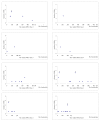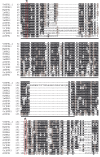Low level of polymorphism in two putative NPR1 homologs in the Vitaceae family
- PMID: 20137081
- PMCID: PMC2832633
- DOI: 10.1186/1745-6150-5-9
Low level of polymorphism in two putative NPR1 homologs in the Vitaceae family
Abstract
Background: Grapevine is subjected to numerous pests and diseases resulting in the use of phytochemicals in large quantities. The will to decrease the use of phytochemicals leads to attempts to find alternative strategies, implying knowledge of defence mechanisms. Numerous studies have led to the identification of signalling pathways and regulatory elements involved in defence in various plant species. Nonexpressor of Pathogenesis Related 1 (NPR1) is an important regulatory component of systemic acquired resistance (SAR) in Arabidopsis thaliana.
Results: Two putative homologs of NPR1 gene were found in the two sequenced grapevine genomes available in the Genoscope database for line 40024 and in the IASMA database for Pinot noir ENTAV 115. We named these two NPR1 genes of Vitis vinifera : VvNPR1.1 and VvNPR1.2. A PCR-based strategy with primers designed on exons was used to successfully amplify NPR1 gene fragments from different Vitaceae accessions. Sequence analyses show that NPR1.1 and NPR1.2 are highly conserved among the different accessions not only V. vinifera cultivars but also other species. We report nucleotide polymorphisms in NPR1.1 and NPR1.2 from fifteen accessions belonging to the Vitaceae family. The ratio of nonsynonymous to synonymous nucleotide substitutions determines the evolutionary pressures acting on the Vitaceae NPR1 genes. These genes appear to be experiencing purifying selection. In some of the species we have analysed one of the two alleles of NPR1.1 contains a premature stop codon. The deduced amino acid sequences share structural features with known NPR1-like proteins: ankyrin repeats, BTB/POZ domains, nuclear localization signature and cysteines. Phylogenetic analyses of deduced amino acid sequences show that VvNPR1.1 belongs to a first group of NPR1 proteins known as positive regulators of SAR and VvNPR1.2 belongs to a second group of NPR1 proteins whose principal members are AtNPR3 and AtNPR4 defined as negative regulators of SAR.
Conclusion: Our study shows that NPR1.1 and NPR1.2 are highly conserved among different accessions in the Vitaceae family. VvNPR1.1 and VvNPR1.2 are phylogenetically closer to the group of positive or negative SAR regulators respectively.
Figures







References
-
- Alleweldt G, Possingham JV. Progress in grapevine breeding. Theoretical and Applied Genetics. 1988;75(5):669–673. doi: 10.1007/BF00265585. - DOI
-
- Galet P. Précis de viticulture. Imprimerie Déhan, Montpellier, France. 1993.
-
- Organisation international de la vigne et du vin. Statistiques vitivinicoles mondiales. http://news.reseau-concept.net/images/oiv/client/Commentaire_Statistique...
Publication types
MeSH terms
Substances
LinkOut - more resources
Full Text Sources
Molecular Biology Databases
Miscellaneous

